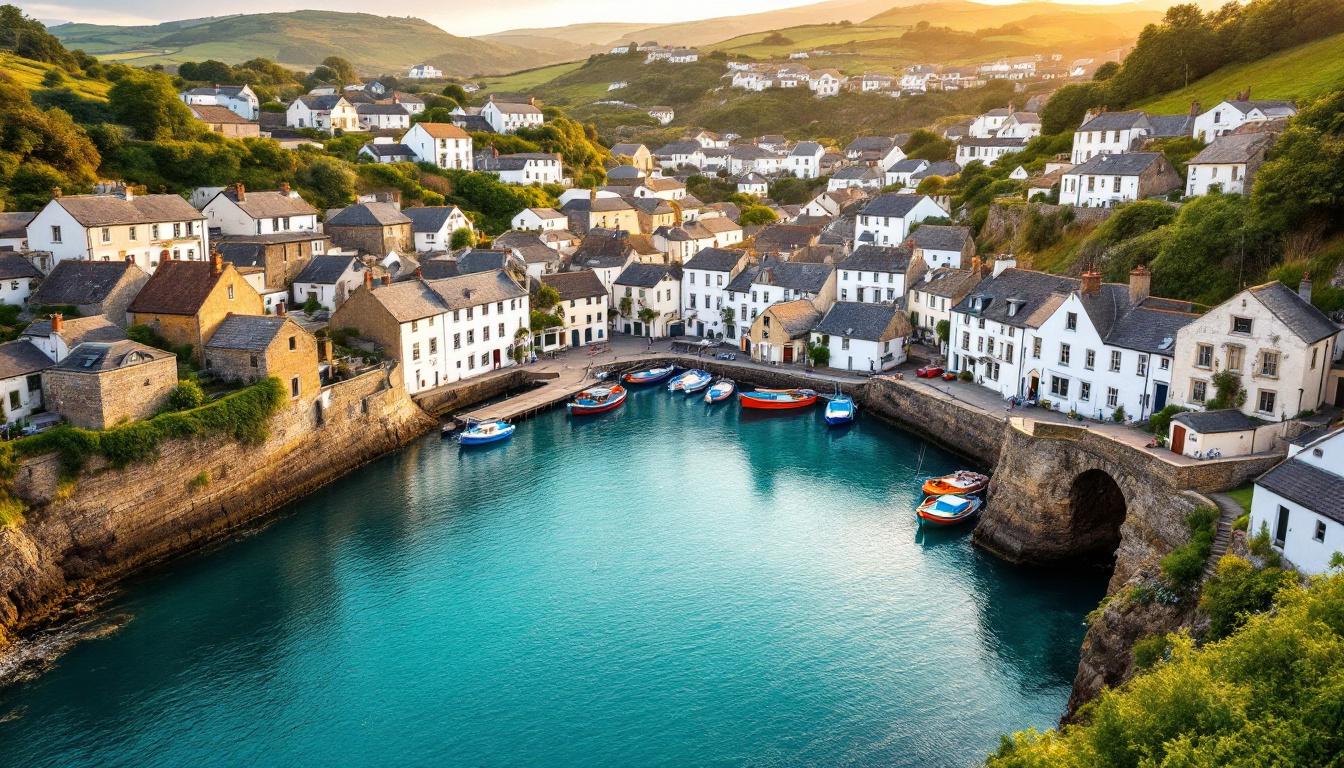St Ives draws 2.5 million visitors annually, creating summer gridlock that transforms Cornwall’s most famous fishing village into a tourist trap. While crowds queue for overpriced cream teas and fight for parking spaces, savvy travelers discover Polperro just 45 minutes east—a genuine Cornish fishing village where authenticity costs 40% less.
This isn’t another “hidden gem” story. Polperro has protected its character through strict vehicle restrictions and community-led preservation efforts. The result? A medieval fishing village where narrow cobblestone lanes wind between 16th-century cottages, completely free from traffic chaos.
Locals call it Porthpyra in Cornish—”Pyra’s cove”—and with only 1,554 residents, this village maintains the intimate scale that St Ives abandoned decades ago. Here’s why switching your Cornwall base saves money while delivering authentic maritime heritage.
Why St Ives disappoints compared to authentic alternatives
Overwhelming summer crowds destroy the experience
St Ives becomes “wall-to-wall tourists” during July, according to local forum discussions spanning decades. Porthmeor Beach disappears under umbrellas, while Tate St Ives requires advance booking. Polperro’s vehicle ban naturally limits visitor numbers, preserving the peaceful atmosphere essential for authentic village exploration.
Commercialization replaces genuine fishing culture
Chain restaurants and souvenir shops dominate St Ives’ harbor area, pricing out traditional businesses. Polperro maintains working fishing boats alongside family-run pubs like The Ship Inn, where conversations with locals reveal smuggling stories passed down through generations. The village’s Heritage Museum of Smuggling and Fishing occupies a 13th-century building—impossible to replicate artificially.
The superior advantages you’ll actually experience in Polperro
Accommodation costs 40% less with better character
Polperro accommodation ranges from £117-197 per night during peak season, compared to St Ives’ £150-300 range. More importantly, you’ll sleep in converted fishermen’s cottages with exposed beams and harbor views, not modern hotels designed for tour groups.
Authentic dining experiences at local prices
Fresh crab sandwiches cost £8-12 at Polperro’s harborside cafés, while St Ives charges £15-25 for similar offerings. The difference? Polperro’s boats still land daily catches at the village quay, eliminating transport costs and ensuring genuine freshness. Local pubs serve Cornish ales alongside stories about the village’s colorful past.
The maritime heritage mass tourism cannot access
Smuggling tunnels and hidden coves require insider knowledge
Polperro’s 18th-century smuggling network included hidden tunnels connecting cellars to secluded beaches. Unlike St Ives’ sanitized history displays, you’ll discover actual hiding spots where contraband brandy and silk entered England illegally. Local guides share precise locations during evening walks—knowledge unavailable in guidebooks.
Traditional fishing practices still visible daily
Morning harbor visits reveal working crab boats preparing for sea, with fishermen maintaining techniques unchanged for centuries. The village’s pilchard fishing heritage continues through small-scale operations, offering photography opportunities impossible in St Ives’ commercial harbor. Traditional Cornish cobbles and lime-washed cottages create authentic backdrops for every photograph.
The practical benefits that matter most
Vehicle restrictions create photographer’s paradise
Polperro’s pedestrian-only village center eliminates modern intrusions from every photograph. Narrow lanes flow naturally between centuries-old buildings, while St Ives battles constant traffic disrupting historic atmosphere. The village’s steep coastal setting provides dramatic elevation changes impossible to capture in flatter alternatives.
Conservation efforts preserve authentic experiences
Community-led initiatives maintain traditional Cornish architecture and protect against overdevelopment. Local businesses focus on Cornish produce and crafts rather than mass-market souvenirs. This preservation creates genuine cultural exchanges with residents who’ve chosen authenticity over tourist revenue.
July 2025 brings peak season challenges everywhere, but Polperro’s natural visitor limits and lower costs make it Cornwall’s smartest alternative. Skip the St Ives queues and discover where authentic Cornish fishing culture survives intact.
Book early July accommodation through local guesthouses rather than booking platforms—you’ll save money while supporting the community preservation efforts that keep Polperro genuine. The village’s character depends on travelers who choose authenticity over convenience.
Planning your authentic Cornish village experience
When should I visit Polperro to avoid crowds?
Early July mornings (before 10am) offer the quietest harbor exploration, while late September through October provides ideal weather with minimal tourists. Vehicle restrictions limit daily visitors naturally, but weekdays remain significantly quieter than weekends even during peak season.
How do I reach Polperro without a car?
Regular buses connect from Looe station (4 miles) with direct trains from London Paddington. The village operates a Park and Ride system from hilltop car parks, with shuttle buses running every 15 minutes during summer months.
What makes Polperro’s smuggling history authentic?
Physical evidence includes original tunnel systems and documented court records from 18th-century prosecutions. The Heritage Museum displays artifacts recovered locally, while guided walks visit actual hiding spots rather than recreated attractions found elsewhere.
Are restaurants expensive compared to other Cornwall villages?
Polperro’s working fishing fleet ensures competitive seafood prices, with fresh crab costing £8-12 versus £15-25 in tourist-focused alternatives. Local pubs maintain traditional pricing for residents, creating authentic dining costs year-round.
Can I photograph freely throughout the village?
The pedestrian-only center eliminates traffic concerns, while narrow lanes and historic architecture provide unlimited photography opportunities. Respect residents’ privacy, but village layout encourages creative documentation of authentic Cornish maritime heritage.
